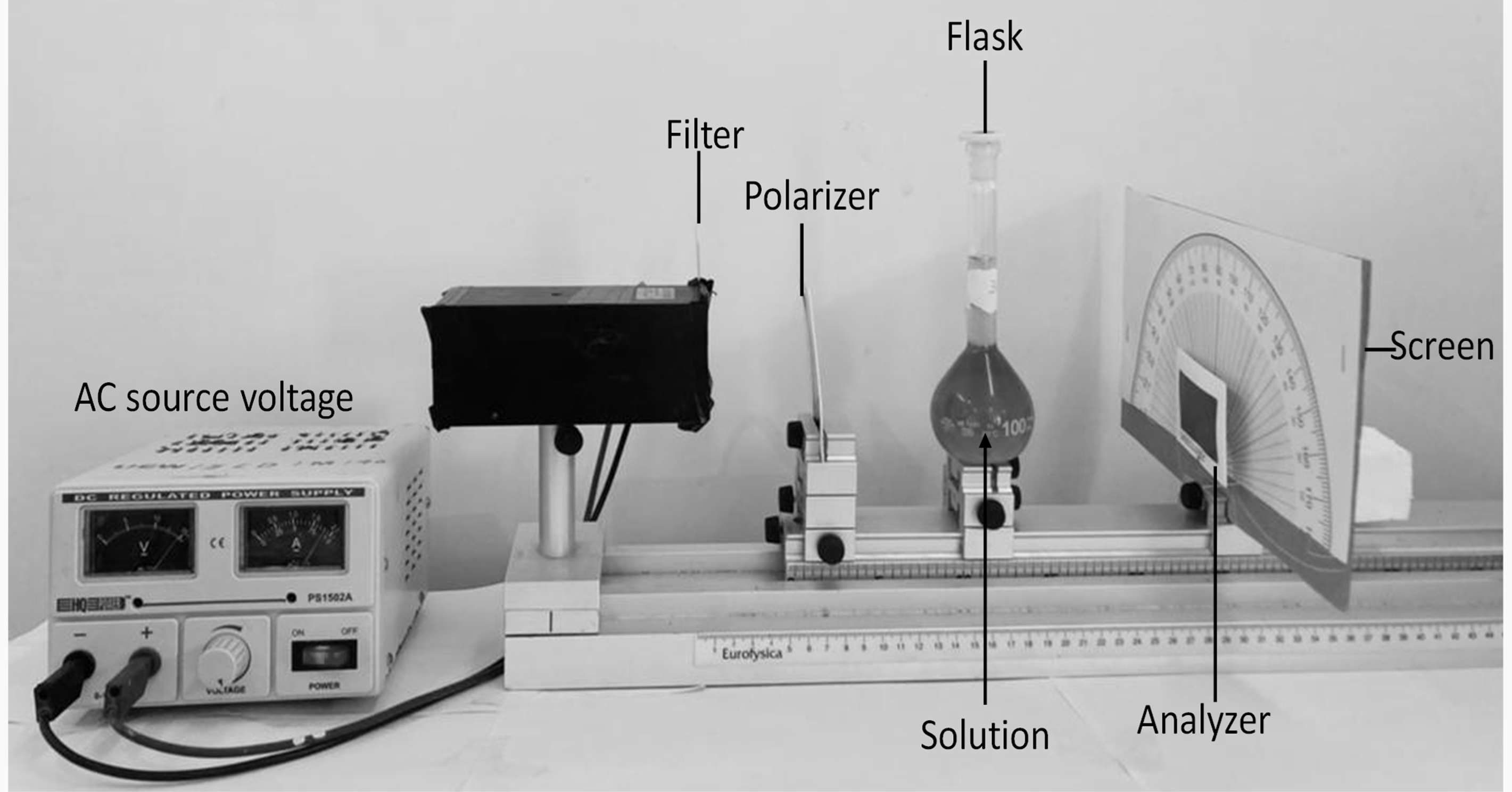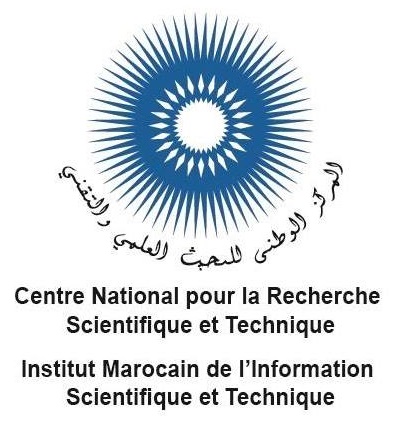Optical characterisation of polarised light beam under different aqueous concentrations
Keywords:
Optical activity, Chiral molecule, Optical filters, Polarised light, Wavelength, Sugar concentrationAbstract
In this study, the optical activity of salt, brown and white sugar solutions of different concentrations is determined. The optical rotation angle as a function of wavelength was studied using different optical color filters. Sodium-D light and laser source of light were used. The optical activity was found to depend on the type of sugar, sugar concentration and the wavelength of the light used. The study revealed that the optical activity was linearly dependent on the concentration of the sugar solution (both white and brown). Cyan light recorded the highest angle of rotation while red light recorded the lowest. It also found that brown sugar has a greater ability to rotate polarized light than white sugar due to the presence of potassium and magnesium components. It is worth noting that the salt solution is optically inactive because it lacks microscopic mirror symmetry. Finally, the findings provide an understanding of the characteristics of polarized light under different solution concentrations and can serve as a guide for conducting further research on high-efficiency polarizers.
Downloads
References
J. M. Ziman, An introduction to science studies: The philosophical and social aspects of science and technology. Cambridge University Press, 1987.
M. B. Vos et al., "Added sugars and cardiovascular disease risk in children: a scientific statement from the American Heart Association," Circulation, vol. 135, no. 19, pp. e1017-e1034, 2017.
J. M. Rippe and T. J. Angelopoulos, "Sugars, obesity, and cardiovascular disease: results from recent randomized control trials," European Journal of Nutrition, vol. 55, no. Suppl 2, pp. 45-53, 2016.
K. L. Stanhope, "Sugar consumption, metabolic disease and obesity: The state of the controversy," Critical reviews in clinical laboratory sciences, vol. 53, no. 1, pp. 52-67, 2016.
R. R. de Souza, D. D. de Sousa Fernandes, and P. H. G. D. Diniz, "Honey authentication in terms of its adulteration with sugar syrups using UV–Vis spectroscopy and one-class classifiers," Food Chemistry, vol. 365, p. 130467, 2021.
C. Chen, Y. Jiang, and J. Kan, "A noninterference polypyrrole glucose biosensor," Biosensors and Bioelectronics, vol. 22, no. 5, pp. 639-643, 2006.
M. K. Islam, T. Sostaric, L. Y. Lim, K. Hammer, and C. Locher, "A validated method for the quantitative determination of sugars in honey using high-performance thin-layer chromatography," JPC–Journal of Planar Chromatography–Modern TLC, vol. 33, pp. 489-499, 2020.
G. F. Mohamed, M. S. Shaheen, S. K. Khalil, A. Hussein, and M. M. Kamil, "Application of FT-IR spectroscopy for rapid and simultaneous quality determination of some fruit products," Nat. Sci, vol. 9, no. 11, pp. 21-31, 2011.
J. D. Kelly and G. Downey, "Detection of sugar adulterants in apple juice using Fourier transform infrared spectroscopy and chemometrics," Journal of Agricultural and Food Chemistry, vol. 53, no. 9, pp. 3281-3286, 2005.
B. Guven, S. Durakli-Velioglu, and I. H. Boyaci, "Rapid identification of some sweeteners and sugars by Attenuated Total Reflectance-Fourier transform infrared (ATR-FTIR), Near-Infrared (NIR) and Raman spectroscopy," G?da, vol. 44, no. 2, pp. 274-290, 2019.
Y. Xu et al., "Raman spectroscopy coupled with chemometrics for food authentication: A review," TrAC Trends in Analytical Chemistry, vol. 131, p. 116017, 2020.
P. I. Richardson, H. Muhamadali, D. I. Ellis, and R. Goodacre, "Rapid quantification of the adulteration of fresh coconut water by dilution and sugars using Raman spectroscopy and chemometrics," Food Chemistry, vol. 272, pp. 157-164, 2019.
M. Soni, "A review on the measurement of optical activity by using a Polarimeter," Journal of Pharmacognosy and Phytochemistry, vol. 8, no. 2, pp. 358-360, 2019.
M. Pokrzywnicka and R. Koncki, "Disaccharides determination: A review of analytical methods," Critical reviews in analytical chemistry, vol. 48, no. 3, pp. 186-213, 2018.
M.-H. Chiu, C.-T. Tan, C. Wang, and J.-N. He, "Phase sensitive optical rotation measurement using the common-path heterodyne interferometry and a half-wave plate at a specific azimuth angle," OSA Continuum, vol. 4, no. 1, pp. 239-251, 2021.
P. John, N. J. Vasa, S. N. Unni, and S. R. Rao, "Glucose sensing in oral mucosa simulating phantom using differential absorption based frequency domain low-coherence interferometry," Applied Optics, vol. 56, no. 29, pp. 8257-8265, 2017.
D. Halliday, R. Resnick, and J. Walker, Fundamentals of physics. John Wiley & Sons, 2013.
D. J. Matti, "Study the Effect of the Sugar Solutions on the Rotation of the Plane of Polarization," Al-Nahrain Journal for Engineering Sciences, vol. 17, no. 1, pp. 60-66, 2014.
J. Thomas, "Fundamentals of physics," ed: American Association of Physics Teachers, 1989.
A. David, "Optical polarization without tools," 2000.
Z. Guo, J. Li, J. Liang, C. Wang, X. Zhu, and T. He, "Regulating Optical Activity and Anisotropic Second-Harmonic Generation in Zero-Dimensional Hybrid Copper Halides," Nano Letters, vol. 22, no. 2, pp. 846-852, 2022.
A. Fazel-Najafabadi and B. Auguié, "Orientation dependence of optical activity in light scattering by nanoparticle clusters," Materials Advances, vol. 3, no. 3, pp. 1547-1555, 2022.
V. Palivec, C. Johannessen, J. Kaminský, and H. Martinez-Seara, "Use of Raman and Raman optical activity to extract atomistic details of saccharides in aqueous solution," PLOS Computational Biology, vol. 18, no. 1, p. e1009678, 2022.
M. Liu et al., "Temperature?controlled optical activity and negative refractive index," Advanced Functional Materials, vol. 31, no. 14, p. 2010249, 2021.
M. Hasanuzzaman et al., "A study on tomato candy prepared by dehydration technique using different sugar solutions," Food and Nutrition Sciences, vol. 2014, 2014.
J. Anderson, C. Gillen, J. Wright, C. S. Adams, and I. G. Hughes, "Optical rotation of white light," American Journal of Physics, vol. 88, no. 3, pp. 247-251, 2020.
S. S. Elwakeel, S. E. Babiker, Y. H. Alsheikh, and K. M. Haroun, "Effect of Sugar Concentration and Type on the Angle of Rotation of Polarized Light," Changes, vol. 75, no. 66.01, pp. 1.096-30, 2019.
K. A. Forbes and D. L. Andrews, "Orbital angular momentum of twisted light: chirality and optical activity," Journal of Physics: Photonics, vol. 3, no. 2, p. 022007, 2021.
E. Nardone, T. Dey, and P. G. Kevan, "The effect of sugar solution type, sugar concentration and viscosity on the imbibition and energy intake rate of bumblebees," Journal of insect physiology, vol. 59, no. 9, pp. 919-933, 2013.
E. Purwandari, R. Hidayat, and B. Cahyono, "Verdet constant of various types of honey and sugar solution analyzed at different concentration," in Journal of Physics: Conference Series, 2021, vol. 1825, no. 1: IOP Publishing, p. 012074.
W. Haynes, "Thermochemistry, electrochemistry, and solution chemistry," CRC Handbook of Chemistry and Physics, pp. 130-131, 2015.
W. M. Haynes, CRC Handbook of Chemistry and Physics. CRC Press, 2016.

Downloads
Published
How to Cite
Issue
Section
ARK
License
Copyright (c) 2023 Desmond Appiah, Victor Antwi, Michael Gyan, Kwesi , Fortune Addo-Wuver

This work is licensed under a Creative Commons Attribution 4.0 International License.
Copyright on any article in the International Journal of Engineering and Applied Physics is retained by the author(s) under the Creative Commons license, which permits unrestricted use, distribution, and reproduction provided the original work is properly cited.
License agreement
Authors grant IJEAP a license to publish the article and identify IJEAP as the original publisher.
Authors also grant any third party the right to use, distribute and reproduce the article in any medium, provided the original work is properly cited.
Most read articles by the same author(s)
- Victor Antwi, Dynamic Force Analysis on Blades of Centrifugal Pumps using Computational Fluids Dynamics Simulations , International Journal of Engineering and Applied Physics: Vol. 3 No. 2: May 2023














